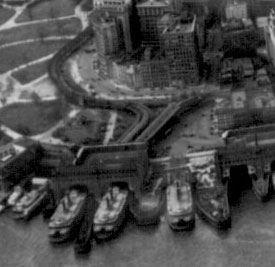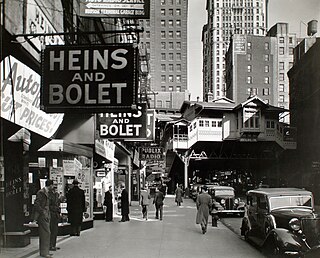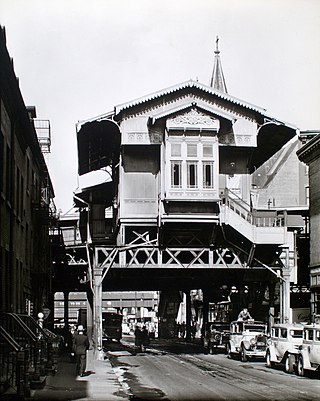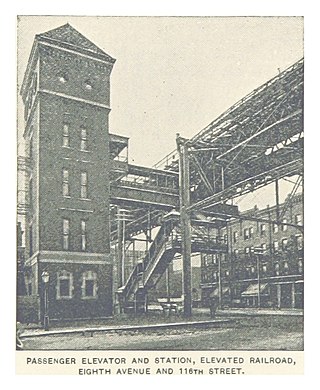Related Research Articles

The South Ferry station was an elevated station at the southern terminal of the IRT Second, Third, Sixth and Ninth Avenue Lines. It was located next to Battery Park at the lower tip of Manhattan, New York City. Two tracks came from the combined Second and Third Avenue Lines, and two from the Sixth and Ninth Avenue Lines, making four tracks at the terminal, with platforms on the outside and between each pair of tracks.

The 161st Street–Yankee Stadium station is a New York City Subway station complex shared by the elevated IRT Jerome Avenue Line and the underground IND Concourse Line. It is located at the intersection of 161st Street and River Avenue in the Highbridge and Concourse neighborhoods of the Bronx. It is generally served by the 4 train at all times; the D train at all times except rush hours in the peak direction ; and the B train during rush hours.
The Battery Place station was a station on the demolished Ninth Avenue and Sixth Avenue elevated train lines in Manhattan, New York City. It was located at the southern terminus of Greenwich Street at the north end of Battery Park.
The Rector Street station was a station on the demolished IRT Ninth Avenue Line in Manhattan, New York City. It was built in 1874, and had two tracks and two side platforms, though two additional tracks ended at a bumper just south of the station. It was served by trains from the IRT Ninth Avenue Line, and was one block west of Rector Street El Station on the IRT Sixth Avenue Line. In 1918, the IRT extended what is today known as the Broadway–Seventh Avenue Line from Times Square down to South Ferry and built their own Rector Street station as one of the stations, serving as competition for the Ninth Avenue Line station. The el station closed on June 11, 1940. The next southbound stop was Battery Place. The next northbound stop was Cortlandt Street for Ninth Avenue Line trains.

The Cortlandt Street station was an express station at Greenwich Street on the demolished IRT Ninth Avenue Line in Manhattan, New York City. It was built as a replacement for the original southern terminus at Dey Street. It had three tracks, one island platform and two side platforms. It was served by trains from the IRT Ninth Avenue Line. It closed on June 11, 1940. The next southbound stop for all trains was Rector Street. The next northbound local stop was Barclay Street. The next northbound express stop was Warren Street.
The Warren Street station was an express station on the demolished IRT Ninth Avenue Line in Manhattan, New York City. It had three tracks, one island platform and two side platforms. It was served by trains from the IRT Ninth Avenue Line. It opened on February 14, 1870 and closed on June 11, 1940. The next southbound local stop was Barclay Street. The next southbound express stop was Cortlandt Street. The next northbound local stop was Franklin Street. The next northbound express stop was Desbrosses Street.
The Franklin Street station was a local station on the demolished IRT Ninth Avenue Line in Manhattan, New York City. It had three tracks and two side platforms. It was served by trains from the IRT Ninth Avenue Line. It opened on January 21, 1873, and closed on June 11, 1940. The next southbound stop was Warren Street. The next northbound stop was Desbrosses Street.
The Desbrosses Street station was an express station on the demolished IRT Ninth Avenue Line in Manhattan, New York City. It had three tracks, one island platform and two side platforms. It was served by trains from the IRT Ninth Avenue Line. It opened on November 23, 1873 and closed on June 11, 1940. The next southbound stop was Franklin Street, while the next southbound express stop was Warren Street. The next northbound stop was Houston Street, while the next northbound express stop was Christopher Street. The station was located one block east of the Desbrosses Street Ferry's slip which provided connections to the railroad terminals in at Exchange Place and Pavonia.
The Houston Street station was a local station on the demolished IRT Ninth Avenue Line in Manhattan, New York City. It had three tracks and two side platforms. It was served by trains from the IRT Ninth Avenue Line. It opened on November 3, 1873 and closed on June 11, 1940. The next southbound stop was Desbrosses Street. The next northbound stop was Christopher Street.

The Christopher Street station was an express station on the demolished IRT Ninth Avenue Line in Manhattan in New York City. It had three tracks, one island platform and two side platforms. It was served by trains from the IRT Ninth Avenue Line. It opened on November 3, 1873 and closed on June 11, 1940. On February 25, 1908, the Hudson and Manhattan Railroad built a subway station just east of this station as part of the extension between Hoboken and 33rd Street. The next southbound local stop was Houston Street. The next southbound express stop was Desbrosses Street. The next northbound stop was 14th Street for all trains.
The 30th Street station was a local station on the demolished IRT Ninth Avenue Line in Manhattan, New York City. It was opened on December 13, 1873 as the replacement for the original northern terminus of the Ninth Avenue Line at 29th Street, which was built in 1868 The station which was originally built by the New York Elevated Railroad Company had two levels. The lower level was built first and had two tracks and two side platforms. The upper level was built as part of the Dual Contracts and had one track that served express trains that bypassed the station. It closed on June 11, 1940. The next southbound stop was 23rd Street. The next northbound stop was 34th Street.
The 66th Street station was an express station on the demolished IRT Ninth Avenue Line in Manhattan, New York City. It had two levels. The lower level was built first and had two tracks and two side platforms. The upper level was built as part of the Dual Contracts and had one track and two side platforms over the lower level local tracks. The station closed on June 11, 1940. The next southbound local stop was 59th Street. The next southbound express stop was 34th Street for Ninth Avenue trains, and 50th Street for IRT Sixth Avenue Line express trains. The next northbound local stop was 72nd Street. The next northbound express stop was 116th Street. The express run from this stop to 116th Street was the longest express segment out of all New York City elevated lines, bypassing seven local stations.

The 42nd Street station was a local station on the demolished IRT Ninth Avenue Line in Manhattan, New York City. It was opened on November 6, 1875, and had two levels. On the lower level, the local trains stopped, on two tracks serving two side platforms. The upper level was built as part of the Dual Contracts and had one track which carried express trains bypassing the station. The next northbound stop was 50th Street. The next southbound stop was 34th Street. The station was closed on June 11, 1940.
The 59th Street station was a local station on the demolished IRT Ninth Avenue Line in Manhattan, New York City. It had two levels. The lower level was built first and had two tracks and two side platforms that served local trains. The upper level was built as part of the Dual Contracts and had one track that served express trains. It closed on June 11, 1940. The next southbound stop was 50th Street for Ninth Avenue trains and Eighth Avenue for IRT Sixth Avenue Line trains. The next northbound stop was 66th Street.
The 86th Street station was a local station on the demolished IRT Ninth Avenue Line in Manhattan, New York City. It had two levels. The lower level was built first and had two tracks and two side platforms and served local trains. The upper level was built as part of the Dual Contracts and had one track that served express trains that bypassed this station. It opened on June 21, 1879 and closed on June 11, 1940. The next southbound stop was 81st Street. The next northbound stop was 93rd Street.
The 104th Street station was a local station on the demolished IRT Ninth Avenue Line in Manhattan, New York City. It had two levels. The lower level was built first and had two tracks and two side platforms and served local trains. The upper level was built as part of the Dual Contracts and had one track that served express trains that bypassed this station. It opened on June 21, 1879, and closed on June 11, 1940. The next southbound stop was 99th Street. The next northbound stop was 116th Street station until June 3, 1903, and then 110th Street. This had a view of the Suicide Curve at 110th Street.

The 110th Street station was a local station on the demolished IRT Ninth Avenue Line in Manhattan, New York City. It had two levels. The lower level was built first and had two tracks and two side platforms and served local trains. The upper level was built as part of the Dual Contracts and had one track that served express trains that bypassed this station. It opened on June 3, 1903, and closed on June 11, 1940. The next southbound stop was 104th Street. The next northbound stop was 116th Street. This station, being the highest in the entire system, was one of the few equipped with elevators. Its high elevation also led to its having a reputation as a popular location for suicide jumps. The common suicides, combined with the line's 90° turns from Ninth Avenue onto Eighth avenue, subsequently earned the station, and the area of track around it, the nickname Suicide Curve.

The 116th Street station was an express station on the demolished IRT Ninth Avenue Line in Manhattan, New York City. It had three tracks and two island platforms. It opened on September 17, 1879, and closed on June 11, 1940. The next southbound local stop was 104th Street station until June 3, 1903, and then 110th Street. The next southbound express stop was 66th Street. The next northbound stop was 125th Street for all trains. The express run from this stop to 66th Street was the longest express segment out of all New York City elevated lines, bypassing seven local stations.
The 125th Street station was an express station on the demolished IRT Ninth Avenue Line in Manhattan, New York City. It had three tracks and two island platforms. It opened on September 17, 1879, and closed on June 11, 1940. The next southbound stop was 116th Street for all trains. The next northbound local stop was 130th Street. The next northbound express stop was 145th Street.
The 151st Street station was a local station on the demolished IRT Ninth Avenue Line in Manhattan, New York City. It had 2 levels. The lower level had two tracks and two side platforms and served local trains. The station was built as part of the Dual Contracts and had one track that served express trains that bypassed this station. The next stop to the north was 155th Street. The next stop to the south was 145th Street. The station opened on November 15, 1917 and closed on June 11, 1940.
References
- ↑ "Tonight to See City Pass Goal of Unification". New York Daily News . June 10, 1940. p. 37. Retrieved June 30, 2019– via Newspapers.com.
